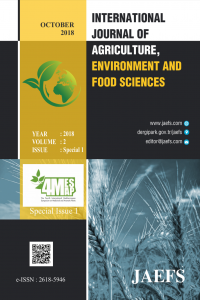Abstract
References
- Ceylan, A. (1983). Medical plants I. Ege University Publication Number:312.
- D' Andrea, L. (2002). Variation of morphology, yield and essential oil components in common chamomile (Chamomilla recutita (L.) Rauschert) cultivars grown in southern Italy. Journal of Herbs, Spices & Medicinal Plants, 9 (4), 359-365.
- EP6, (2007). European pharmacopoeia sixth edition. Council of Europe, Strasbourg: France.
- Gruenwald, J. (2004). PDR for Herbal Medicines, Thomson, 1-988.
- Lopez, M., Blazquez, M.A. (2016). Characterization of the essential oils from commercial chamomile flowers and chamomile teabags by GC-MS analysis. International Journal of Pharmacognosy and Phytochemical Research; 8(9), 1487-1491.
- Kazemi, M. (2014). Chemical composition and antimicrobial activity of essential oil of Matricaria chamomilla. Bull. Env. Pharmacol. Life Sci., 3 (2), 148-153.
- Pirzad, A., Alyari, H., Shakiba, M.R., Zehtap-Salmasi, S., Mohammadi, A. (2008). Essential oil content and composition of german chamomile (Matricaria chamomilla L.) at different ırrigation regimes. Journal of Agronomy, 5 (3), 451-455.
- Singh, O., Khanam, Z., Misra, N., Srivasta, M.K. (2011). Chamomile (Matricaria chamomilla L.): An overview. Pharmacogn Rev., 5 (9), 82–95.
- Sharafzadeh, S., Alizadeh, O. (2011). German and Roman chamomile. Journal of Applied Pharmaceutical Science 01 (10), 01-05.
- Tan, U. (2016). Effects of different sowing times and varieties of German Chamomile (Chamomilla recutita L.) on agronomic technological characteristics. Adnan Menderes University Institute of Science and Technology, 53p.
- Zeybek, U., Haksel, M. (2011). Important Medicinal Plants and Their Usage in Turkey and the World. ARGEFAR and Helvacizade publishing, 192p.
Essential oil yield and compositions of chamomile (Matricaria Chamomilla L.) cultivated in different province of Turkey
Abstract
In this study, it was investigated essential oil yield and compositions
of Chamomile (Matricaria chamomilla L.) cultivated in Konya
and Karaman ecological conditions, Turkey. Essential oil yield of chamomile was
determined as 0.73 % in Konya and 0.62 % in Karaman. The most important
essential oil component of chamomile, kamazulen content is 1.13 % in Konya location and 1.36 % in Karaman location. Alpha-bisabolol
content from the essential oil components
in the Konya and Karaman province was determined as 38.60% and 27.36%,
respectively. The aim of this research attempts to
contribute to knowledge of differences between essential oil yield and components of Chamomile (Matricaria chamomilla L.)
cultivated in Konya and Karaman ecological conditions, Turkey.
References
- Ceylan, A. (1983). Medical plants I. Ege University Publication Number:312.
- D' Andrea, L. (2002). Variation of morphology, yield and essential oil components in common chamomile (Chamomilla recutita (L.) Rauschert) cultivars grown in southern Italy. Journal of Herbs, Spices & Medicinal Plants, 9 (4), 359-365.
- EP6, (2007). European pharmacopoeia sixth edition. Council of Europe, Strasbourg: France.
- Gruenwald, J. (2004). PDR for Herbal Medicines, Thomson, 1-988.
- Lopez, M., Blazquez, M.A. (2016). Characterization of the essential oils from commercial chamomile flowers and chamomile teabags by GC-MS analysis. International Journal of Pharmacognosy and Phytochemical Research; 8(9), 1487-1491.
- Kazemi, M. (2014). Chemical composition and antimicrobial activity of essential oil of Matricaria chamomilla. Bull. Env. Pharmacol. Life Sci., 3 (2), 148-153.
- Pirzad, A., Alyari, H., Shakiba, M.R., Zehtap-Salmasi, S., Mohammadi, A. (2008). Essential oil content and composition of german chamomile (Matricaria chamomilla L.) at different ırrigation regimes. Journal of Agronomy, 5 (3), 451-455.
- Singh, O., Khanam, Z., Misra, N., Srivasta, M.K. (2011). Chamomile (Matricaria chamomilla L.): An overview. Pharmacogn Rev., 5 (9), 82–95.
- Sharafzadeh, S., Alizadeh, O. (2011). German and Roman chamomile. Journal of Applied Pharmaceutical Science 01 (10), 01-05.
- Tan, U. (2016). Effects of different sowing times and varieties of German Chamomile (Chamomilla recutita L.) on agronomic technological characteristics. Adnan Menderes University Institute of Science and Technology, 53p.
- Zeybek, U., Haksel, M. (2011). Important Medicinal Plants and Their Usage in Turkey and the World. ARGEFAR and Helvacizade publishing, 192p.
Details
| Primary Language | English |
|---|---|
| Subjects | Agricultural Engineering |
| Journal Section | Research Articles |
| Authors | |
| Publication Date | October 7, 2018 |
| Submission Date | June 1, 2018 |
| Acceptance Date | June 24, 2018 |
| Published in Issue | Year 2018 Volume: 2 Issue: Special 1 |
Cite
Cited By
The International Journal of Agriculture, Environment and Food Sciences content is licensed under a Creative Commons Attribution-NonCommercial (CC BY-NC) 4.0 International License which permits third parties to share and adapt the content for non-commercial purposes by giving the appropriate credit to the original work. Authors retain the copyright of their published work in the International Journal of Agriculture, Environment and Food Sciences.
Web: dergipark.org.tr/jaefs E-mail: editor@jaefs.com WhatsApp: +90 850 309 59 27



